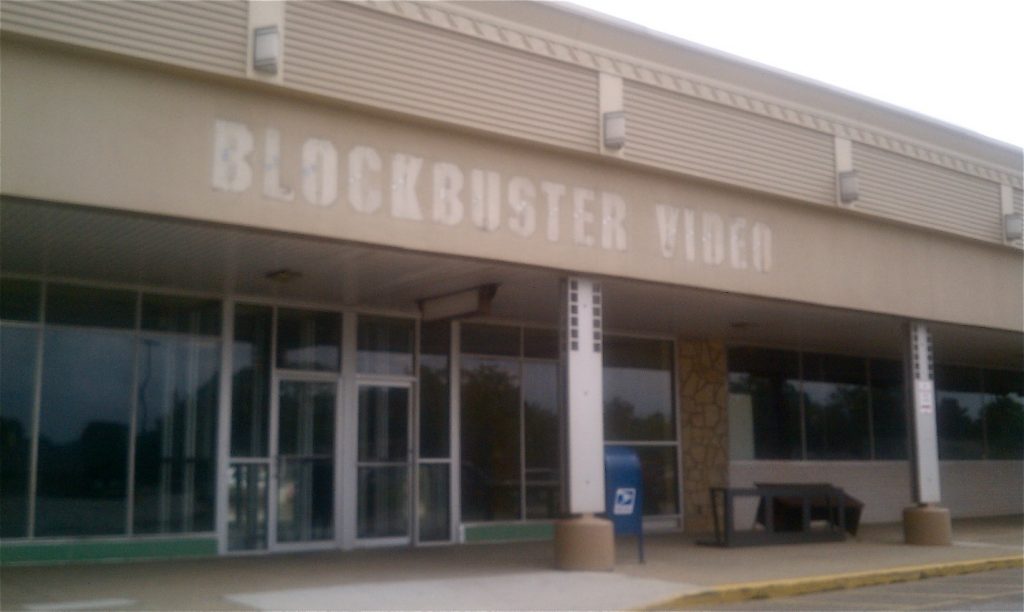Digital innovation continues to disrupt industries at lightning speed. Today’s organizations are transforming their entire business – from strategy to operations, technology to culture – to better deliver value to their customers. In 2017, we compiled the top 10 trends leaders needed to know when it came to their digital transformation journey. In this 10-week blog series, we’ll further explore each trend and address how you can continue to modernize your business for success.
Come along with me on a journey back in time: a time when the internet was shiny and new.
It’s 1998 and you just fired up your brand new tangerine iMac when your friend sends you a message on AIM asking if you’ve heard about this new DVD service called Netflix.
You have not.
So you head over to a brand new search website called Google, and you type “What is Netflix?” You click on the first result and are sent to Netflix.com where you see this:

This is a completely different experience for you because a typical Friday night involves stopping at your local Blockbuster, heading straight for the back wall, and looking for hot titles like “I Know What You Did Last Summer” and “G.I. Jane.” Proud of your status as an early adopter, you walk right past everyone looking at the VHS movies and head straight to the wall of DVDs where you see this:

But that was 20 years ago. Ancient history. Let’s fast forward 10 years to compare how the two brands evolved.
It’s now 2008. You just fired up your brand new ultra-thin MacBook Air notebook when your best friend texts you on your iPhone 3G, asking if you feel like watching a movie this weekend. You have already watched all three of your Netflix DVDs, and you’ve put them back in their self-sealing envelopes to ship back. You log on to Netflix.com to learn that they now have unlimited streaming. Their website has changed quite a bit in ten years:

Unlimited movie rentals? That sounds amazing! You decide to sign up later, but for tonight, you need a movie, so you head over to Blockbuster, which still looks like this:

Fast forward to today. Your friend texts you on your smartwatch and asks if you want to watch a movie tonight. You fire up your Roku to see what is streaming and decide to figure it out once she gets there, certain that you will find something binge-worthy:

She arrives with take-out from your favorite Chinese restaurant. Coincidentally, the one located right next door to where Blockbuster used to be.

Which Path Will You Take?
If Socrates had spoken at a Harvard 2017 commencement, his advice would still ring true:
“The secret of change is to focus all of your energy, not on fighting the old, but on building the new.” – Socrates
Digital transformation isn’t optional anymore. The customer is in the driver’s seat. You either grow along with your customers, or you end up becoming the anchor store in an abandoned strip mall.
The Good, The Bad, And The Ugly
Your customers expect an exceptional experience. If your website, your customer service agents or your supply chain don’t move fast enough, then they will find someone who moves faster.
One week to ship my product? Too long.
One minute to load a website? On to the next.
Five minutes to hold for a customer service representative? Nope.
To your customers, time is the new money. Your job is to find ways to manufacture time. This is done by making experiences faster, smoother and easier.
The Good
It can be done.
The Bad
It’s going to cost money.
The Ugly
It will probably take longer than you anticipate.
Where’s the Money?
“An investment in knowledge pays the best interest.” – Benjamin Franklin
According to The Hackett Group’s Key Issues Study, finance leaders of global companies with more than $1 billion in revenue said they expected finance department budgets to be cut 1.3% in 2018. That’s not good news, but it does get a little bit better. Unlike in 2016 and 2017, cutting finance budgets is not one of the top two objectives for the company.
The number one objective is “supporting enterprise information/analytics needs” closely followed by “supporting enterprise digital transformation.”
While the budget may be smaller, the available budget is more likely to be funneled into digital transformation efforts.
According to a Forbes report, 85 percent of business executives will allocate up to 25 percent of their total budget to digital transformation. 2018 will reveal record amounts spent on digital.
The 3 Step Plan to Avoid Becoming Blockbuster
Step 1
Communicate. Digital transformation starts in a very human place. It starts with the relationship between the CIO, CEO, and CFO. While the CFO holds the purse strings, the CEO drives the vision. Without buy-in from the top, your digital transformation initiatives will struggle to gain traction.
“Regardless of their experience—or their personal interest in digital transformation—it’s agreed that CEOs need to get onboard with not just allowing, but in leading, the change.” – Daniel Newman, Futurum
Customer expectations in 2018 are not what they were 2015, 2016, or 2017. What was optional then is critical now. Visitors may have tolerated your non-mobile website last year. This year, not so much.
Look Beyond the Quarterly Earnings
Long-term benefits rarely coincide with quarterly goals. Digital transformation takes many months to several years. You will spend the money now and see the return in a year…or two.
That’s not an easy sell.
But consider the alternative of doing nothing.
Step 2
Find a great partner. Knowing what you want to do and actually being able to do it, are two very different things. It’s relatively easy to determine that your user experience needs improvement. Simply take a look at your website’s bounce rate or the negative reviews on Yelp.
Fixing it? That’s much harder.
Step 3
Be patient. Once you decide to jump in, it could take years to see a return on your investment. According to Forbes , only 11 percent see returns within a year, while more than a third wait at least two years for a full return on that investment.
Convincing your CFO to make an investment that may take years to recoup is a difficult sell, but it’s not impossible. Consider the following two scenarios:
Choose not to invest in digital transformation:
Ashley goes to your website to purchase an item she needs this weekend. It loads very slowly, but she’s patient. She finds what she is looking for and adds it to her cart. When she goes to pay, she gets an error message.
Ashley is annoyed and buys her product somewhere else.
This bad experience prevents her from buying from you now and in the future. She is so frustrated that she writes a negative review on Google.
She tells two friends, and then they tell two friends. The damage is done.
Result: Ignoring digital transformation positively impacts your expenses today. And yet, in the long run, it can negatively impact your future income.
Choose to invest in digital transformation:
Ryan goes to your website to purchase an item he needs this weekend. He pulls it up quickly on his phone, adds it to his cart, swipes to pay, and is done within 3 minutes.
He’s so happy that he vows to always buy from you, regardless of price, because it was easy and fun to buy. He then writes a positive review on Google.
He tells two friends, and then they tell two friends. Business is booming.
Result: Investing in digital transformation may increase your expenses today. And yet, it can positively impact your income in the future.
Back to the Future
“Next year” has arrived. What started as a want is now a need.
It’s never easy to find the money, but when the lack of investment causes potential customers to leave and never come back, it can no longer be ignored.
Ready Player One
Your customer’s expectations are evolving at breathtaking speeds. Investing in technology is no longer about reducing costs and increasing efficiency. The investment today is all about the customer experience.
“While investment strategies for digital transformation have traditionally been influenced by an organization’s desire to improve operational performance and reduce costs, respondents have shown that future investment strategies will shift to more strategic opportunities – chief among these being improving the customer experience,” said Srikant Sastry, national managing principal of advisory services at Grant Thornton, in a statement. “The simple truth is that more than three-quarters of the executives surveyed feel that digital transformation is critical for their company.” – Accounting Today
Your CFO will be more likely to invest in areas where she can either see measurable, proven, success or where you can demonstrate that your lack of innovation is causing a loss.
Digital transformation doesn’t need to be an all or nothing proposition. You can take one small step at a time:
- Identify customer pain points
- Translate those pain points into dollars lost. (abandoned carts, decrease in website visits)
- Determine a way to fix just one, small pain point
- Invest a small budget
- Measure. Measure. Measure.
We all want to hang onto our money, and your CFO is no different. She will invest where she’s sure she will see results.
Which Path Will Your Brand Choose?
No one knows what Netflix will look like in 2028, but one thing is certain – it will evolve and look nothing like it does today.
What about your business? Will you be the next Blockbuster, or adapt and evolve like Netflix?
Do you want to read more about the top ten digital transformation trends?
Click here to read about trend six: Brewing an Addictive Mobile Experience


Excellent post Sharon.